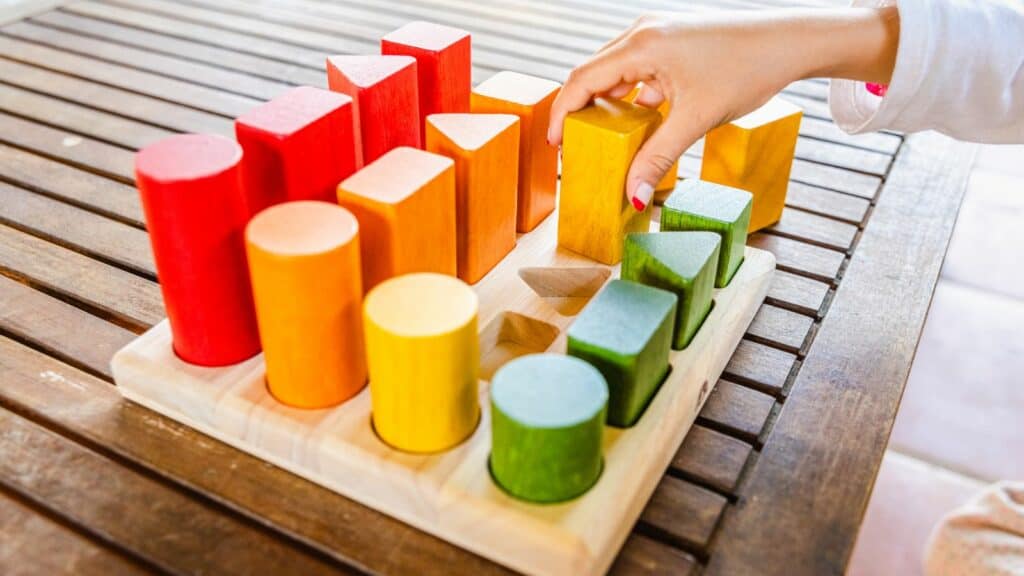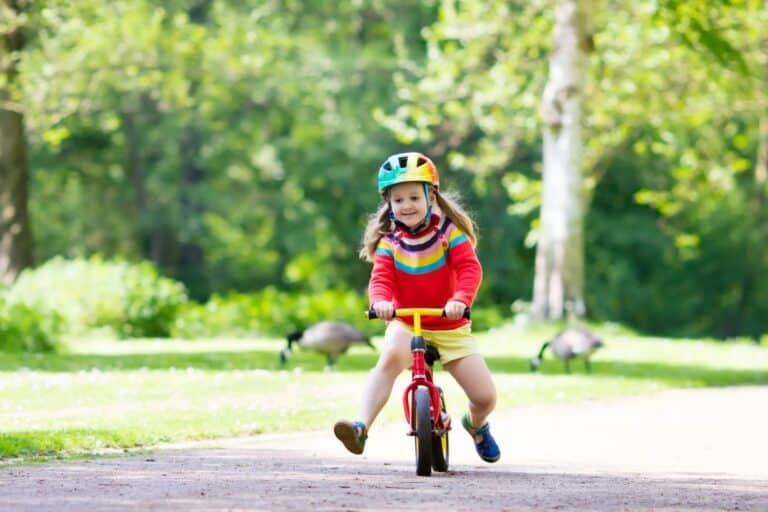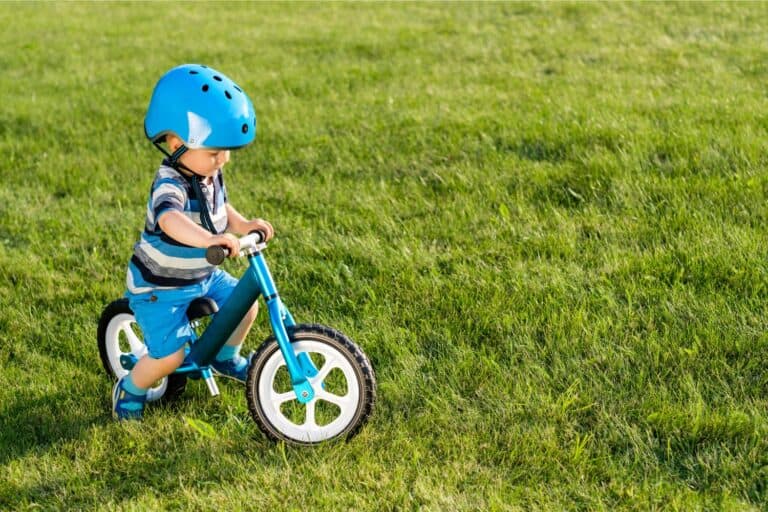Montessori Toys: The Benefits of This Educational Approach for Children’s Play

If you’re a parent or caregiver, you’re likely always looking for toys to help your child develop essential skills. Montessori toys have become increasingly popular in recent years, as they are designed to encourage children to build, interact, learn, and manipulate in ways that promote independence and creativity. These toys are inspired by the Montessori method of education, which emphasizes hands-on learning and self-directed activities.

Montessori toys are designed to be engaging, challenging, safe, and developmentally appropriate. They are often made from natural materials like wood and fabric and are free from batteries and other electronic components. This allows children to focus on the sensory experience of playing with the toy and to use their imaginations to create their own stories and scenarios.
- What are Montessori Toys?
- Benefits of Montessori Toys
- Choosing the Right Montessori Toys
- Top 10 Montessori Toys
- DIY Montessori Toys
- What is considered Montessori toys?
- Why is Montessori toys so expensive?
- What is the difference between Montessori toys and regular toys?
- Why are there no plastic toys in Montessori?
- Why don’t Montessori toys have color?
- How can you tell if a toy is Montessori?
Whether you’re looking for toys that promote fine motor skills, problem-solving abilities, or social-emotional development, there are Montessori toys available for every age and stage of childhood. Keep reading to learn more about the benefits of Montessori toys and to discover some of the best options on the market today.
What are Montessori Toys?
If you’re looking for toys that promote hands-on learning and encourage creativity in your child, Montessori toys might be the right choice. Montessori toys are designed to align with the principles of Montessori education, emphasizing child-led learning, independence, and respect for the child’s natural development.
Principles of Montessori Education
Montessori education is based on the idea that children are naturally curious and eager to learn. The role of the teacher is to guide the child’s learning by providing a prepared environment that is safe, stimulating, and responsive to the child’s needs. Montessori education emphasizes:
- Child-led learning: Children are encouraged to follow their interests and pace of learning.
- Independence: Children are given the freedom and responsibility to make choices and solve problems independently.
- Respect for the child’s natural development: Children are seen as capable individuals actively participating in their learning.
Characteristics of Montessori Toys
Montessori toys are designed to promote hands-on learning and encourage creativity. They are typically made from natural materials like wood, metal, and fabric and are designed to be simple and open-ended. Montessori toys should:
- Encourage exploration and discovery.
- Promote independence and problem-solving.
- Be age-appropriate and developmentally appropriate.
- Be safe and durable.
- Be aesthetically pleasing and engaging.
Some examples of Montessori toys include:
| Age Range | Examples |
|---|---|
| Infant/Toddler | Simple wooden blocks, stacking toys, shape sorters, puzzles |
| Preschool | Dress-up clothes, play kitchen, art supplies, building blocks |
| Elementary | Science kits, musical instruments, board games, outdoor exploration tools |
Montessori toys are not meant to entertain children but rather to engage them in meaningful learning experiences promoting their natural development. By providing children with toys that align with the principles of Montessori education, you can help foster a love of learning and a sense of independence in your child.
Benefits of Montessori Toys
Developmental Benefits
Montessori toys offer a plethora of developmental benefits for children. Firstly, they promote sensory exploration, which helps children develop their senses of touch, sight, sound, and more. Montessori toys also foster fine motor skills as children manipulate and interact with the toys, enhancing their hand-eye coordination and dexterity.
Moreover, Montessori toys encourage children to be independent and self-sufficient. Playing with montessori toys teaches children how to problem-solve and think critically, which helps them develop their cognitive abilities. Children who play with Montessori toys also tend to be more confident and self-assured, as they are given the freedom to explore and learn at their own pace.
Related Post: Top 5 Best Infant Toys For Your Newborn
Educational Benefits
In addition to the developmental benefits, Montessori toys also offer educational benefits. These toys are designed to be open-ended, meaning they can be used in various ways and for different purposes. This allows children to use their creativity and imagination, which helps them develop their cognitive and social skills.
Montessori toys also help children learn about cause-and-effect relationships. Children can see how their actions impact the world around them by manipulating the toys, allowing them to develop their understanding of the physical world. Additionally, Montessori toys are often designed to be realistic, which helps children develop their knowledge of the world around them.
Choosing the Right Montessori Toys
When choosing Montessori toys for your child, it’s essential to consider several factors to ensure that they are safe, age-appropriate, and of high-quality materials. This section will discuss age-appropriateness, safety considerations, and material quality to help you make the best choices for your child.
Age Appropriateness
Montessori toys are designed to meet the developmental needs of children at different stages of their lives. Therefore, choosing appropriate toys for your child’s age is essential to ensure that they can use them safely and effectively. For example, if you’re looking for toys for infants, you should choose toys that are easy to grasp, have contrasting colors, and make different sounds to stimulate their senses. For toddlers, you can select toys that promote hand-eye coordination and fine motor skills, such as puzzles, blocks, and shape sorters.
For preschoolers, you can choose more complex toys that promote problem-solving skills, creativity, and imagination. Examples include building sets, art supplies, and musical instruments. However, it’s important to remember that children develop at different rates, so it’s essential to observe your child’s interests and abilities to choose suitable toys.
Safety Considerations
Children’s safety should always be a top priority when choosing Montessori toys. Ensure that the toys you select are free from small parts that can pose a choking hazard, sharp edges or corners, and toxic materials. You should also choose easy-to-clean toys to prevent the spread of germs and bacteria.
Supervising your child when playing with toys is essential to ensure they use them safely and appropriately. Teach your child to put away their toys after playing to prevent accidents and tripping hazards.
Material Quality
Montessori toys are designed to stimulate children’s senses and promote their development. Therefore, it’s essential to choose toys made from high-quality materials that are durable, safe, and environmentally friendly. Wooden toys, for example, are popular for Montessori toys because they are natural, non-toxic, and long-lasting. You can also choose toys made from natural fibers, such as cotton or wool, which are soft, warm, and gentle on your child’s skin.
When choosing Montessori toys, it’s important to remember that the quality of the materials used can affect your child’s experience and learning. Therefore, invest in well-made toys designed to last, so your child can enjoy them for years to come.
Related Post: 8 Of The Best Baby Blocks For Your Baby’s Development
Top 10 Montessori Toys
If you’re looking for Montessori toys to help your child learn and develop important skills, here are some of the best options:
- Wooden Blocks: These classic toys are perfect for encouraging creativity and imagination. They also help develop fine motor skills and hand-eye coordination.
- Object Permanence Box: This toy helps babies understand that objects still exist even when they can’t see them. It’s a great way to develop their cognitive skills and hand-eye coordination.
- Shape Sorter: A shape sorter is a great way to help toddlers learn about shapes and colors. It also helps develop their problem-solving skills and hand-eye coordination.
- Lacing Beads: Lacing beads are a fun way to develop fine motor skills and hand-eye coordination. They also help children learn about colors, patterns, and shapes.
- Rainbow Stacker: A rainbow stacker is a great way to help toddlers learn about colors and sizes. It also helps develop their problem-solving skills and hand-eye coordination.
- Wooden Puzzles: Wooden puzzles are a great way to help children develop problem-solving skills and hand-eye coordination. They also help them learn about shapes, colors, and patterns.
- Sensory Balls: Sensory balls are a great way to help babies develop their tactile and sensory skills. They’re also great for encouraging hand-eye coordination and gross motor skills.
- Balance Board: A balance board is a great way to help children develop balance and coordination. It’s also a fun way to encourage physical activity and exercise.
- Play Kitchen: A play kitchen is a great way to encourage imaginative play and creativity. It also helps children develop their social and emotional skills.
- Musical Instruments: Musical instruments are a great way to help children develop their sense of rhythm and musicality. They also help develop fine motor skills and hand-eye coordination.
Overall, Montessori toys are a great way to help children learn and develop important skills. You can help your child develop creativity, problem-solving skills, hand-eye coordination, and more by providing your child with these toys.
DIY Montessori Toys
DIY Montessori toys are a great option if you’re looking for a budget-friendly way to incorporate Montessori principles into your child’s playtime. Not only do they save you money, but they also allow you to customize the toys to your child’s interests and abilities.
One popular DIY Montessori toy is the sensory bottle. These bottles can be filled with various materials, such as water, glitter, and small toys, to provide a sensory experience for your child. You can also add food coloring to the water to create a visually stimulating effect.
Another easy DIY Montessori toy is the posting box. Find a small box with a lid, cut a hole in the top, and provide your child with small objects to post through the hole. This toy helps develop hand-eye coordination and fine motor skills.
If you want to create a more complex DIY Montessori toy, consider making a Montessori-inspired busy board. These boards are typically made from a piece of wood and feature various objects for your child to manipulate, such as locks, latches, and buttons. In addition, you can customize the board to include things that interest your child, such as toy cars or animals.
Overall, DIY Montessori toys are a great way to provide your child with engaging and educational play experiences. By creating toys tailored to your child’s interests and abilities, you can help foster a love of learning and exploration from an early age.
What is considered Montessori toys?
Montessori toys are designed to promote learning and development in children, based on the principles of the Montessori educational philosophy. As a general rule, montessori toys are often made from natural materials, such as wood or cloth, and are designed to be simple and open-ended, allowing children to explore and discover independently.
Montessori toys are typically focused on promoting fine motor development, hand-eye coordination, problem-solving, and creativity rather than encouraging passive play. Montessori toys include blocks, puzzles, stacking toys, shape sorters, and sensory toys such as playdough or sand.
Related Post: Is Lovevery Worth It? An Honest Review of Lovevery Play Kits
Why is Montessori toys so expensive?
Montessori toys can be more expensive than traditional toys for a few reasons.
Firstly, Montessori toys are often made from high-quality, natural materials such as wood or cloth, which can be more expensive than plastic or synthetic materials. These materials are chosen for their durability, sustainability, and sensory qualities, which are essential aspects of the Montessori approach to learning.
Secondly, Montessori toys are often designed to be open-ended and versatile, allowing children to use them in various ways and promoting creativity and problem-solving skills. However, this requires careful design and attention to detail, which can also add to the cost of production.
Finally, many Montessori toys are handmade or produced in small batches by independent manufacturers, which can also contribute to their higher costs. In addition, these manufacturers may prioritize ethical and sustainable production practices, which can also add to the cost of production.
Overall, while Montessori toys may be more expensive than traditional toys, they are often seen as an investment in a child’s learning and development, as they are designed to promote skills and qualities such as independence, creativity, and problem-solving that can benefit children throughout their lives.
What is the difference between Montessori toys and regular toys?
The main difference between Montessori and regular toys is their focus on promoting child-led learning and development. Montessori toys are designed to encourage children to explore and learn through play rather than simply providing entertainment. Here are some key differences between Montessori toys and regular toys:
- Open-ended vs. Prescriptive: Montessori toys are often open-ended, meaning that they can be used in various ways and allow for creativity and exploration. In contrast, regular toys are often more prescriptive, with specific functions and playing methods.
- Natural Materials vs. Synthetic Materials: Montessori toys are often made from natural materials such as wood, cloth, and metal, which are chosen for their sensory qualities and durability. In contrast, regular toys are often made from synthetic materials such as plastic, which can be less durable and environmentally friendly.
- Skill Development vs. Entertainment: Montessori toys are designed to promote specific skills and qualities, such as fine motor development, hand-eye coordination, problem-solving, and creativity. In contrast, traditional toys are often designed primarily for entertainment value.
- Child-Led vs. Adult-Led: Montessori toys are designed to be used independently by children, allowing them to explore and learn at their own pace. In contrast, regular toys may require more adult supervision or direction.
Overall, the main difference between Montessori toys and regular toys is their focus on promoting child-led learning and development through open-ended play and natural materials.
Why are there no plastic toys in Montessori?
The Montessori approach to education emphasizes the importance of using natural materials in toys and learning materials. Natural materials provide a more authentic and sensory experience for children and are better suited to promoting exploration, creativity, and problem-solving.
Plastic toys, on the other hand, are often made from synthetic materials that can be less durable and less environmentally friendly than natural materials. They may also be designed to be more prescriptive and less open-ended, limiting children’s opportunities for exploration and creativity.
In addition, plastic toys can be less engaging for children than toys made from natural materials, as they often lack the sensory qualities such as texture, weight, and smell that are important for promoting exploration and learning.
Overall, while plastic toys can be useful in some contexts, the Montessori approach emphasizes the importance of using natural materials in toys and learning materials to promote a more authentic and engaging learning experience for children.
Why don’t Montessori toys have color?
Montessori toys often prioritize natural materials and simplicity in design, which can lead to a lack of bright colors. The Montessori approach to education emphasizes the importance of promoting exploration and discovery through sensory experiences. Natural materials such as wood, metal, and cloth provide children with a more authentic and engaging sensory experience.
In addition, the Montessori approach encourages children to develop their sense of aesthetics and appreciation for beauty rather than relying on external cues such as bright colors or flashy designs. Using simple, natural materials in their toys and learning materials, Montessori educators aim to promote a sense of calm and focus in the learning environment, allowing children to engage more deeply with their surroundings and their learning process.
While Montessori toys may not have bright colors, they are often designed to be visually appealing in other ways, such as using natural textures and patterns. This can help to promote a sense of wonder and curiosity in children, encouraging them to explore and discover the world around them in their own unique way.
How can you tell if a toy is Montessori?
There are a few key characteristics that can help you identify if a toy is Montessori:
- Open-ended design: Montessori toys are often designed to be open-ended, meaning that they can be used in various ways and allow for creativity and exploration. Look for toys that can be used in multiple ways rather than those with a prescriptive or limited use.
- Natural materials: Montessori toys are often made from natural materials such as wood, cloth, and metal, which are chosen for their sensory qualities and durability. Look for toys that are made from natural materials rather than synthetic materials such as plastic.
- Skill development: Montessori toys are designed to promote specific skills and qualities, such as fine motor development, hand-eye coordination, problem-solving, and creativity. Look for toys with a clear educational purpose rather than those for entertainment.
- Child-led play: Montessori toys are designed to be used independently by children, allowing them to explore and learn at their own pace. Look for toys that encourage independent play and exploration rather than those that require adult supervision or direction.
- Simple design: Montessori toys often have a simple design with minimal decoration or bright colors. Look for toys that have a clean and simple design rather than those that are overly flashy or busy.
The key to identifying a Montessori toy is to look for toys that prioritize natural materials, open-ended play, skill development, child-led play, and simple design.
Other Posts You Might Like:
Best Melissa and Doug Toys for 0 to 12 Months Old






